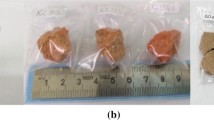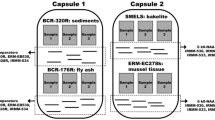Abstract
The objective of this work was to compare the results obtained by the relative INAA and k 0-INAA methods for the same input parameters (sample mass, nuclear data, net peak area for the same gamma line and the same measurement and same cooling and measurement times). In total eight environmental soil and sediment reference materials (RM) or certified reference materials (CRM) from different producers were analysed. In this work only the recommended or certified values were considered, allowing comparison of the two methods for 30 elements. The results point out that k 0-INAA possesses superior qualities compared to relative INAA, being insensitive to flux gradients, and independent of recommended/certified values in RMs/CRMs, often used as standards in relative INAA.


Similar content being viewed by others

References
De Corte F, Simonits A (2003) Recommended nuclear data for use in the k 0 standardization of neutron activation analysis. At Data Nucl Data Tables 85:47–67
Snoj L, Žerovnik G, Trkov A (2012) Computational analysis of irradiation facilities at the JSI TRIGA reactor. Appl Radiat Isot 70:483–488
HyperLab 2002 System (2002) Installation and quick start guide. HyperLabs Software, Budapest
Jaćimović R, Smodiš B, Bučar T, Stegnar P (2003) k 0-NAA quality assessment by analysis of different certified reference materials using the KAYZERO/SOLCOI software. J Radioanal Nucl Chem 257:659–663
Kayzero for Windows (KayWin®), User’s Manual for reactor neutron activation analysis (NAA) using the k 0 standardization method, Version 2, November 2005
ISO 13528:2005 (2005) Statistical methods for use in proficiency testing by interlaboratory comparisons. ISO, Genève
The 2012 recommended k 0-database (2012) http://www.kayzero.com/k0naa/k0naa/News/News.html Accessed 14 Mar 2012
Kennedy G, St-Pierre J (2003) Is the k 0 method accurate for elements with high Q 0 values? J Radioanal Nucl Chem 257:475–480
St-Pierre J, Kennedy G (2006) Re-measurement of Q 0 and k 0 values for 14 nuclides. Nucl Instrum Methods A 564:669–674
Farina Arbocco F, Vermaercke P, Smits K, Sneyers L, Strijckmans K (2013) Experimental determination of k 0, Q 0, Ēr factors and neutron cross-sections for 41 isotopes of interest in neutron activation analysis. J Radioanal Nucl Chem 296:931–938
Jaćimović R (2003) Evaluation of the use of the TRIGA Mark II reactor for the k 0-method of activation analysis (in Slovene). PhD Thesis, University of Ljubljana
Acknowledgments
The author is grateful for financial support from the Slovenian Research Agency (ARRS) through programme P1-0143 and the Metrology Institute of the Republic of Slovenia (MIRS) under MIRS/IJS contract No. 6401-5/2009/27 for activities and obligations performed as a Designate Institute as an etalon (standard of measurement) for amount of substance in soil.
Author information
Authors and Affiliations
Corresponding author
Rights and permissions
About this article
Cite this article
Jaćimović, R. Comparison of relative INAA and k 0-INAA using soil and sediment reference materials. J Radioanal Nucl Chem 300, 663–672 (2014). https://doi.org/10.1007/s10967-014-3071-8
Received:
Published:
Issue Date:
DOI: https://doi.org/10.1007/s10967-014-3071-8



